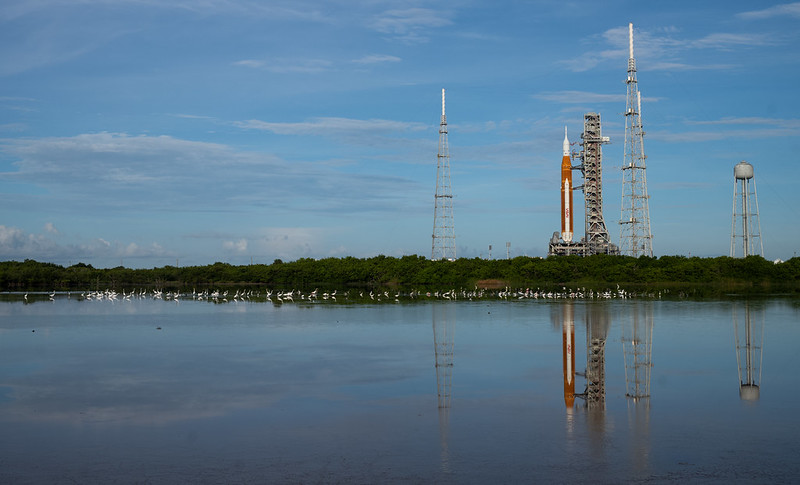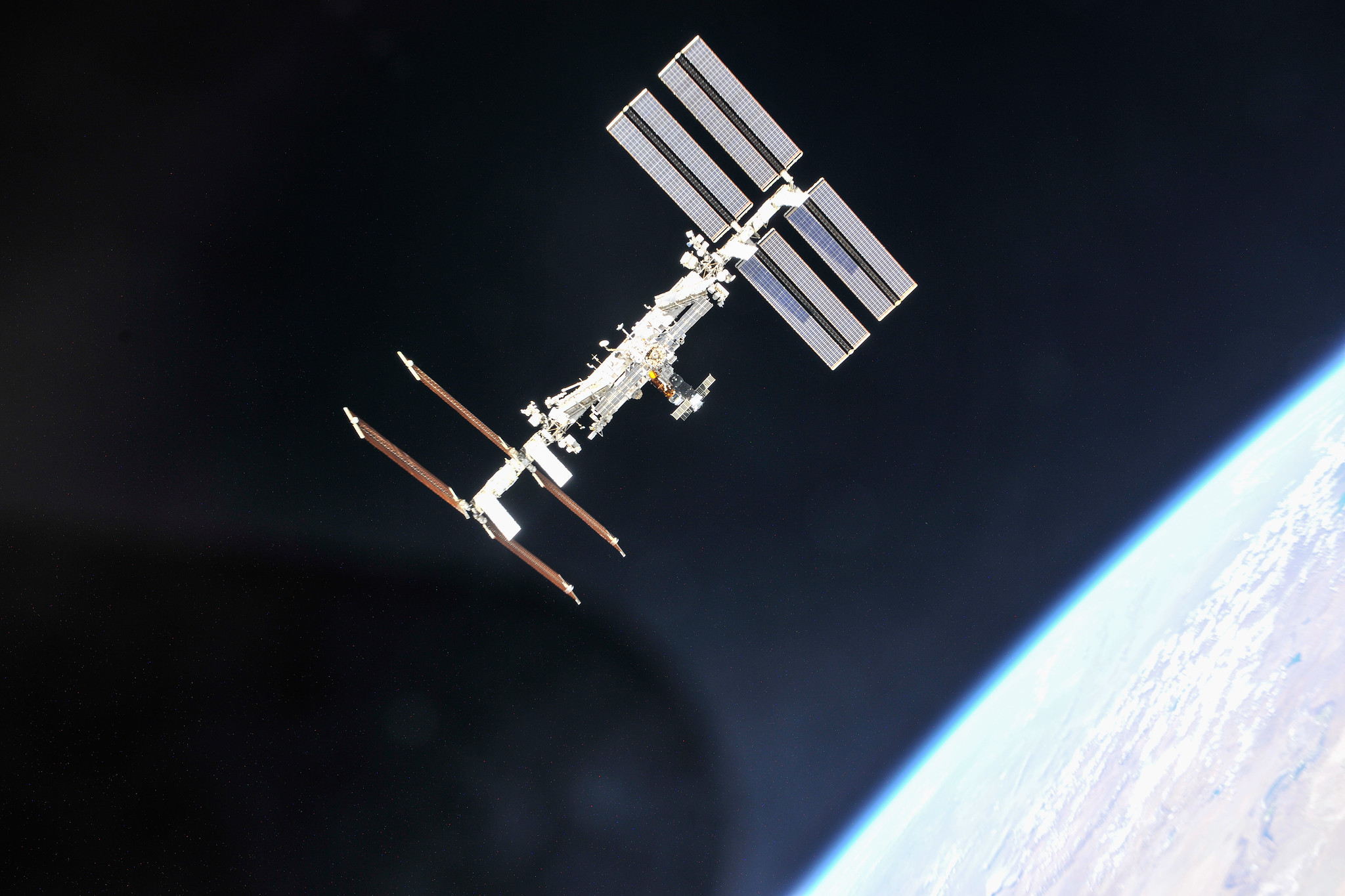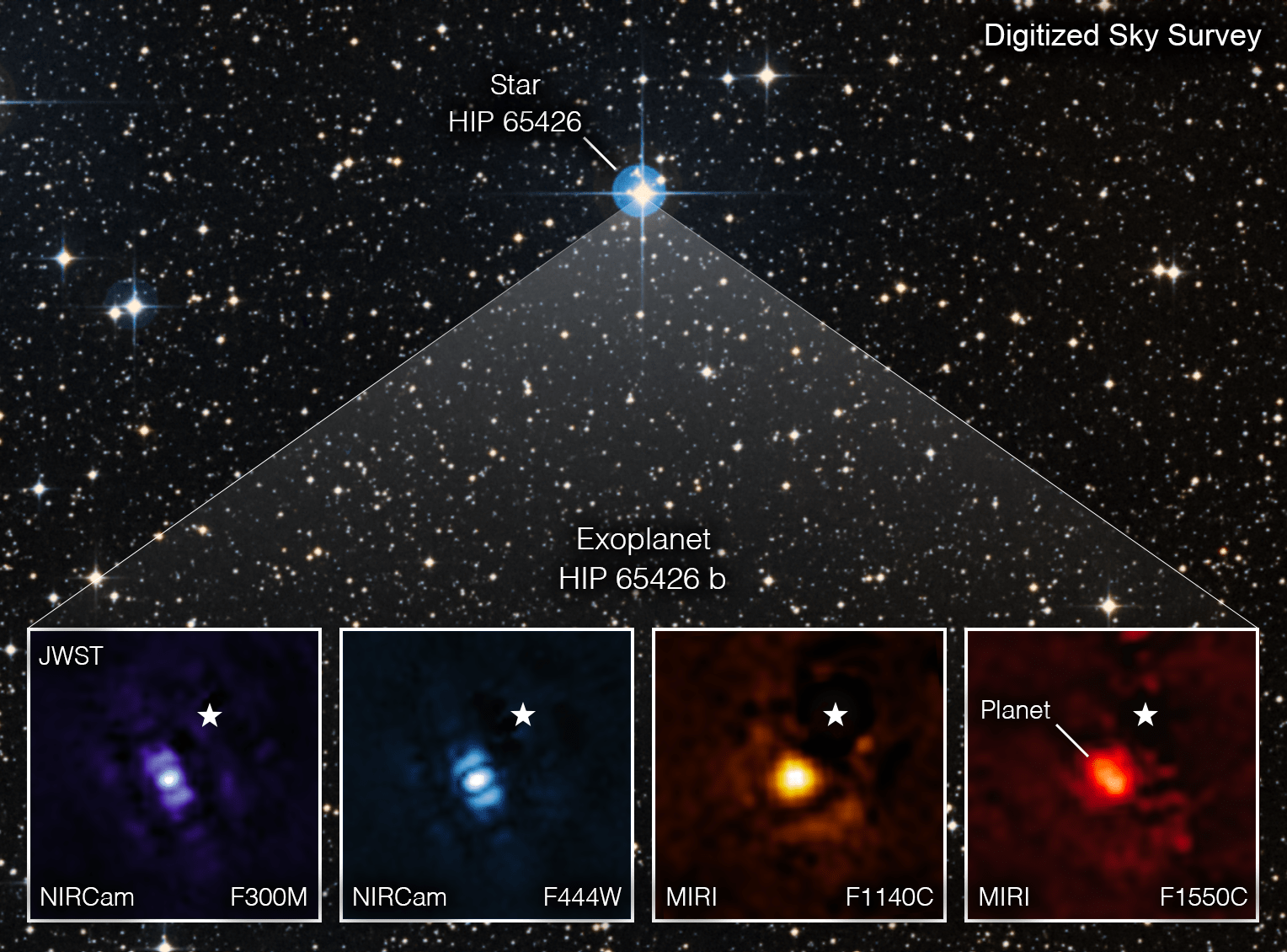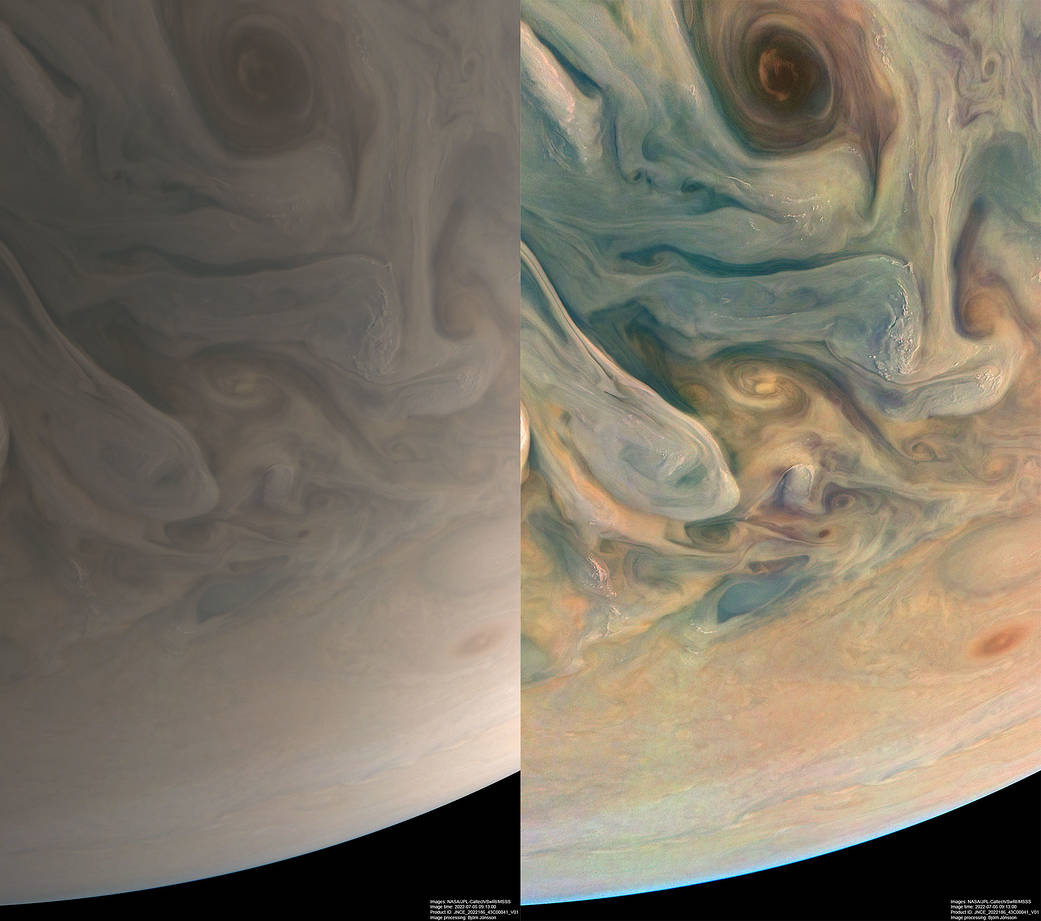In This Week’s Star
- Teams Continue to Review Options for Next Artemis I Launch Attempt
- NASA Awards Contract for Marshall’s Mission Operations
- NASA, Axiom Sign Second Private Astronaut Mission to Space Station Order
- NASA’s Webb Takes Its First-Ever Direct Image of Distant World
- NASA’s Juno Mission Reveals Jupiter’s Complex Colors
- Crew 5 Date Change Highlighted on ‘This Week at NASA’
Teams Continue to Review Options for Next Artemis I Launch Attempt
After standing down on the Artemis I launch attempt Sept. 3 due to a hydrogen leak, teams have decided to replace the seal on an interface, called the quick disconnect, between the liquid hydrogen fuel feed line on the mobile launcher and the Space Launch System (SLS) rocket while at the launch pad.

Performing the work at the pad requires technicians to set up an enclosure around the work area to protect the hardware from the weather and other environmental conditions, but enables engineers to test the repair under cryogenic, or supercold, conditions. Performing the work at the pad also allows teams to gather as much data as possible to understand the cause of the issue. Teams may return the rocket to the Vehicle Assembly Building (VAB) to perform additional work that does not require use of the cryogenic facilities available only at the pad.
To meet the current requirement by the Eastern Range for the certification on the flight termination system, NASA would need to roll the rocket and spacecraft back to the VAB before the next launch attempt to reset the system’s batteries.
Additionally, teams will also check plate coverings on other umbilical interfaces to ensure there are no leaks present at those locations. With seven main umbilical lines, each line may have multiple connection points.
NASA Awards Contract for Marshall’s Mission Operations
NASA has awarded the Marshall Operations Systems, Services, and Integration II (MOSSI II) contract to Teledyne Brown Engineering Inc. of Huntsville.
The contract calls for providing provide the ground systems and operations services necessary to meet the requirements delegated to the Payload and Mission Operations Division within the Human Exploration Development and Operations Office at the agency’s Marshall Space Flight Center. Work will be performed on-site at Marshall and other locations as required including NASA’s Johnson Space Center and Kennedy Space Center.
The performance-based, cost-plus-award-fee contract has a potential mission services value of $596.5 million and a maximum potential indefinite-delivery/indefinite-quantity value of $85 million. The contract begins about Sept. 9, 2022, with a two-year base period, followed by six one-year option periods, and a six-month option to extend services period that may be exercised at NASA’s discretion.
Under the contract, Teledyne Brown Engineering will be responsible for providing International Space Station payload operations and ground systems; test, launch, flight, and ground operations for NASA’s Space Launch System rocket; flight operations and ground systems for the Near-Earth Asteroid Scout CubeSat mission; and Delay Tolerant Network protocol variants definition, prototyping, and testing; as well as provide ground systems to support test, launch, and flight operations for other program and projects.
NASA, Axiom Sign Second Private Astronaut Mission to Space Station Order
NASA and Axiom Space have signed a mission order for the second private astronaut mission to the International Space Station to take place in the second quarter of 2023.
“With each new step forward, we are working together with commercial space companies and growing the economy in low-Earth orbit,” said Phil McAlister, director of commercial space at NASA Headquarters. “In addition to expanding access to orbit for more people, we are also hoping these private astronaut missions will help the industry learn and develop the skillset to conduct such missions, and NASA is benefitting from gaining additional capability, particularly with returning additional cargo from the space station.”
The spaceflight, designated as Axiom Mission 2 (Ax-2), will launch from NASA’s Kennedy Space Center and travel to the space station. Once docked, the Axiom astronauts are scheduled to spend 10 days aboard the orbiting laboratory. NASA and Axiom mission planners will coordinate in-orbit activities for the private astronauts to conduct in coordination with space station crew members and flight controllers on the ground.
“Axiom Space’s Ax-2 mission builds upon the success of Ax-1, which demonstrated our team’s ability to work collaboratively with our partners at NASA and SpaceX to plan and execute a complex human spaceflight mission,” said Derek Hassmann, Axiom’s chief of Mission Integration and Operations. “Axiom continues to fund and fly private astronaut missions to the International Space Station to build our expertise and attract new customers in preparation for the launch of our space station, Axiom Station. Our new Ax-2 crew, together with a full mission manifest of science, outreach, and commercial activities, will continue to increase utilization of the International Space Station National Laboratory and demonstrate to the world the benefits of commercial space missions for all humanity.”
For the Ax-2 mission, Axiom Space will submit four proposed crew members and four back up crew to the station’s Multilateral Crew Operations Panel for review. NASA is currently requiring all private astronaut mission providers to select a previously flown NASA astronaut as the spacecraft commander, and Axiom will comply with that requirement for Ax-2. Following review and approval from NASA and its international partners, the prime crew members for the mission will be named.
The Ax-2 crew members will train for their flight with NASA, international partners, and SpaceX, which Axiom has contracted as launch provider for transportation to and from the space station and who will familiarize the private astronauts with systems, procedures, and emergency preparedness for the space station and the Dragon spacecraft. Based on current mission planning, team crew training is scheduled to begin this fall.
In December 2021, NASA announced the selection of Axiom Space for negotiations for the second private astronaut mission. To conduct the mission, Axiom is obtaining NASA services via both the mission specific order and Reimbursable Space Act Agreements.
Through the mission specific order, Axiom is obtaining from NASA services such as crew supplies, cargo delivery to space, storage, and other in-orbit resources for daily use. The order also accommodates up to an additional contingency week aboard the space station. This mission is subject to NASA’s updated pricing policy for private astronaut missions, which reflects the full value of services the agency is providing to Axiom that are above space station baseline capabilities.
The order also identifies capabilities NASA will obtain from Axiom, including the return of scientific samples that must be kept cold in transit back to Earth, the return of a Nitrogen/Oxygen Recharge System tank, the capability for last-minute return of two cargo transfer bags, and up to 10 hours of the private astronaut mission commander’s time during the docked mission to complete NASA science or perform tasks for NASA.
Through Reimbursable Space Act Agreements, Axiom will reimburse NASA for services to enable the mission, such as training for crew members and use of facilities at NASA’s Johnson Space Center and Kennedy Space Center. In addition, SpaceX has a Reimbursable Space Act Agreement with Kennedy for launch services.
In October 2021, the Human Exploration Development & Operations Office at NASA’s Marshall Space Flight Center hosted a payload training event at the Payload Operations Center for the Ax-1 mission astronauts, who conducted a dedicated microgravity research mission. The training – previously provided only to U.S. Orbital Segment astronauts – offered the Axiom astronauts an understanding of NASA payload operations integration and crew interfaces, exposure to Marshall’s facilities and capabilities, and opportunities to build relationships with payload operations integration team members in the preflight timeframe.
For more than 21 years, NASA has supported a continuous U.S. human presence in low-Earth orbit. The agency’s goal is a low-Earth orbit marketplace where NASA is one of many customers, and the private sector leads the way. This strategy will provide services the government needs at a lower cost, enabling the agency to focus on its Artemis missions to the Moon and on to Mars while continuing to use low-Earth orbit as a training and proving ground for those deep space missions.
Learn more about how NASA is fostering a robust commercial low-Earth orbit economy here.
NASA’s Webb Takes Its First-Ever Direct Image of Distant World
For the first time, astronomers have used NASA’s James Webb Space Telescope to take a direct image of a planet outside our solar system. The exoplanet is a gas giant, meaning it has no rocky surface and could not be habitable.
The image, as seen through four different light filters, shows how Webb’s powerful infrared gaze can easily capture worlds beyond our solar system, pointing the way to future observations that will reveal more information than ever before about exoplanets.
“This is a transformative moment, not only for Webb but also for astronomy generally,” said Sasha Hinkley, associate professor of physics and astronomy at the University of Exeter in the United Kingdom, who led these observations with a large international collaboration. Webb is an international mission led by NASA in collaboration with its partners, the European Space Agency and the Canadian Space Agency.
The exoplanet in Webb’s image, called HIP 65426 b, is about six to 12 times the mass of Jupiter, and these observations could help narrow that down even further. It is young as planets go – about 15 to 20 million years old, compared to our 4.5-billion-year-old Earth.
Astronomers discovered the planet in 2017 using the SPHERE instrument on the European Southern Observatory’s Very Large Telescope in Chile and took images of it using short infrared wavelengths of light. Webb’s view, at longer infrared wavelengths, reveals new details that ground-based telescopes would not be able to detect because of the intrinsic infrared glow of Earth’s atmosphere.
Researchers have been analyzing the data from these observations and are preparing a paper they will submit to journals for peer review. But Webb’s first capture of an exoplanet already hints at future possibilities for studying distant worlds.
Since HIP 65426 b is about 100 times farther from its host star than Earth is from the Sun, it is sufficiently distant from the star that Webb can easily separate the planet from the star in the image.
Webb’s Near-Infrared Camera (NIRCam) and Mid-Infrared Instrument (MIRI) are both equipped with coronagraphs, which are sets of tiny masks that block out starlight, enabling Webb to take direct images of certain exoplanets like this one. NASA’s Nancy Grace Roman Space Telescope, slated to launch later this decade, will demonstrate an even more advanced coronagraph.
“It was really impressive how well the Webb coronagraphs worked to suppress the light of the host star,” Hinkley said.
Taking direct images of exoplanets is challenging because stars are so much brighter than planets. The HIP 65426 b planet is more than 10,000 times fainter than its host star in the near-infrared, and a few thousand times fainter in the mid-infrared.
In each filter image, the planet appears as a slightly differently shaped blob of light. That is because of the particulars of Webb’s optical system and how it translates light through the different optics.
“Obtaining this image felt like digging for space treasure,” said Aarynn Carter, a postdoctoral researcher at the University of California, Santa Cruz, who led the analysis of the images. “At first all I could see was light from the star, but with careful image processing I was able to remove that light and uncover the planet.”
While this is not the first direct image of an exoplanet taken from space – the Hubble Space Telescope has captured direct exoplanet images previously – HIP 65426 b points the way forward for Webb’s exoplanet exploration.
“I think what’s most exciting is that we’ve only just begun,” Carter said. “There are many more images of exoplanets to come that will shape our overall understanding of their physics, chemistry, and formation. We may even discover previously unknown planets, too.”
The Webb team at NASA’s Marshall Space Flight Center spent more than two decades working on Webb, primarily focusing on development and testing of the mirrors in extreme cold temperatures at which Webb operates.
NASA’s Juno Mission Reveals Jupiter’s Complex Colors
NASA’s Juno spacecraft observed the complex colors and structure of Jupiter’s clouds as it completed its 43rd close flyby of the giant planet on July 5. Citizen scientist Björn Jónsson created these two images using raw data from the JunoCam instrument aboard the spacecraft. At the time the raw image was taken, Juno was about 3,300 miles above Jupiter’s cloud tops, at a latitude of about 50 degrees. North is up. At that moment, the spacecraft was traveling at about 130,000 mph relative to the planet. The first image (left) was processed to portray the approximate colors that the human eye would see from Juno’s vantage point. The second image (right) comes from the same raw data, but in this case Jónsson digitally processed it to increase both the color saturation and contrast to sharpen small-scale features and to reduce compression artifacts and noise that typically appear in raw images. This clearly reveals some of the most intriguing aspects of Jupiter’s atmosphere, including color variation that results from differing chemical composition, the three-dimensional nature of Jupiter’s swirling vortices, and the small, bright “pop-up” clouds that form in the higher parts of the atmosphere. Juno is the second mission competitively selected under NASA’s New Frontiers Program, which is managed at NASA’s Marshall Space Flight Center. (Credits: Image data: NASA/JPL-Caltech/SwRI/MSSS. Image processing by Björn Jónsson © CC NC SA).
Crew 5 Date Change Highlighted on ‘This Week at NASA’
NASA and SpaceX are now targeting no earlier than 11:45 p.m. CDT on Oct. 3 for the launch of the agency’s Crew-5 mission to the International Space Station. The new date is highlighted on “This Week @ NASA,” a weekly video program broadcast on NASA-TV and posted online.
The launch date adjustment was made to accommodate spacecraft traffic coming to and leaving from the space station. NASA astronauts Nicole Mann and Josh Cassada, Japan Aerospace Exploration Agency astronaut Koichi Wakata, and Roscosmos cosmonaut Anna Kikina will launch aboard a SpaceX Crew Dragon spacecraft from NASA’s Kennedy Space Center.
The Payload Operations Center at Marshall houses the International Space Station Payload Operations Integration Center, the Laboratory Training Complex and simulation rooms used to prepare for space station expeditions.
View this and previous episodes at “This Week @NASA” on NASA’s YouTube page.





























